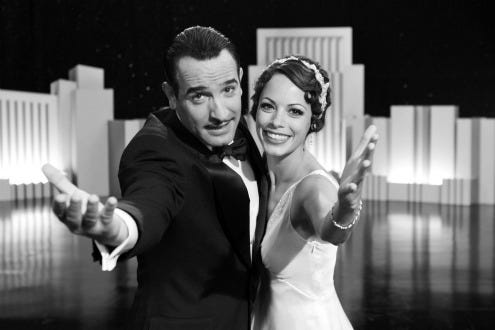The Artist

Love, love, love!
For the first time in 2011, I have fallen, madly, for a movie. "The Artist" is a French film (but about, and largely of, Americans) that is in black-and-white and silent (!) to boot.
Never fear. This is not a snooty art-house film intended only for people wearing black turtlenecks. It's a rapturous movie full of passion and artistry, self-aware but not self-absorbed. "The Artist" is about moviemaking, in the way that great Hollywood movies have turned a loving (yet acerbic) gaze at themselves, like "Singin' in the Rain."
I cite "Singin' " because star Jean Dujardin reminded me very much of Gene Kelly in that film, with a heavy dash of Douglas Fairbanks Jr. thrown in. With a pencil mustache, slicked hair and rascal smile, he plays George Valentin, an aging matinee idol of silent films who finds his star falling with the advent of "talkies," or sound pictures.
At the same time, Peppy Miller (Bérénice Bejo) — love that name — the sparkly young ingénue who literally bumps into Valentine at one of his premieres and causes a stir, becomes the biggest light in Hollywood's new age of sound.
When I say that "The Artist" is silent, it is not of course absolutely lacking sound like the films before 1929, which were accompanied by a live orchestra or recorded music. Writer/director Michel Hazanavicius had the ingenious idea of showing us one of Valentin's movies first, operating under the familiar principle of demonstrative acting broken up by title cards for dialogue.
But then the camera pulls back to show the movie-within-a-movie being made — but the people's mouths still flap soundlessly and written dialogue provides their words for us.
Hazanavicius retains this charade throughout ... with two notable exceptions that fidget with the film's internal conventions.
The wonderful original score by Ludovic Bource is essential to the story since virtually every second of film is accompanied by music. Bource also mixes in samples of scores from other movies; the great Bernard Herrmann's eerie/gorgeous theme from "Vertigo," one of my favorite pieces of movie music, is employed beautifully in one pivotal scene.
There is a love affair between Valentin and Peppy, but it's pure and chaste. He's unhappily married — Penelope Ann Miller plays the wife, and the dissolution of their relationship is shown in a montage that pays homage to "Citizen Kane" — and isn't the type to stray.
Although Valentin is undeniably a ham and is overly fond of himself, he isn't a cad. He just loves the limelight, so when it's yanked away he folds into himself, like a flower denied the sun.
A number of recognizable American actors take supporting parts in the film, and it's a hoot to watch them attack silent acting. James Cromwell plays Valentin's doting chauffeur, who sticks by him even when his wages disappear. John Goodman is the chief at Kinograph Studios — not an entirely bad fellow but one who always knows where the greenbacks are. Missi Pyle plays a starlet tired of being upstaged by Valentin's showboating.
When the talkies invade, Valentin refuses to make the jump, insisting that audiences never needed to hear him talk before. It's stubborn pride, and even he knows this, but nothing can push him to compromise his artistic integrity.
It's an interesting exercise to consider exactly how serious an artist Valentin was. Truly, he made daffy little pictures in which he always played the handsome adventurer, accompanied by his smart little dog (who is his best friend in real life, too). Essentially, he starred in adventure serials that were already getting stale before sound pictures came along.
Hazanavicius harkens back to the first decades of movies — even using the old-fashioned 1.37 aspect ratio — with a mix of reverent nostalgia and modern ingenuity. "The Artist" isn't really a deep meditation on art and movies but a joyful celebration of filmmaking and filmmakers.
5 Yaps



